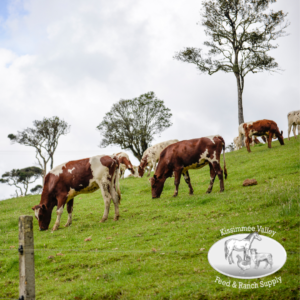 Considerations for this growing season: Applying fertilizer to pastures and fields is important to maximize yield and forage quality. But with fertilizer prices higher than normal around the country, you can take steps to manage costs and still make a big impact. To help justify applying fertilizer this year, have your soil analyzed. You can save yourself a lot of money if you already have the correct nitrogen, phosphorus, calcium and potassium levels in your soil. If the soil lacks just one of those nutrients, focus on the single nutrient instead of all nutrients when fertilizing. Also, don’t overlook manure as a fertilizer. Look to your drylots as a source of extra soil nutrients to spread across pastures, or purchase poultry litter if it is available locally.
Considerations for this growing season: Applying fertilizer to pastures and fields is important to maximize yield and forage quality. But with fertilizer prices higher than normal around the country, you can take steps to manage costs and still make a big impact. To help justify applying fertilizer this year, have your soil analyzed. You can save yourself a lot of money if you already have the correct nitrogen, phosphorus, calcium and potassium levels in your soil. If the soil lacks just one of those nutrients, focus on the single nutrient instead of all nutrients when fertilizing. Also, don’t overlook manure as a fertilizer. Look to your drylots as a source of extra soil nutrients to spread across pastures, or purchase poultry litter if it is available locally.
1) Move mineral sites to enhance grazing.
When first putting mineral out, especially during hot temperatures, place mineral tubs or feeders near loafing areas, water sources and shade. Once cattle start consuming mineral consistently, you can spread mineral locations out further into the pasture. If you have undergrazed pasture areas, you can move the mineral sites to those areas to help guide cattle to graze there.
You’ll also get better pasture utilization by putting distance between mineral feeders and other self-fed products or hay sources, since cattle will graze along the path between them. However, you should keep at least 100 yards (about the size of a football field) between products to avoid creating a “buffet line” situation where cattle just hop from one product to the next and possibly increasing consumption.
Also consider environmental conditions for mineral placement. If you are in an area with frequent rain, consider moving mineral sites to avoid mud build-up and to ensure consistent access.
2) Know how many feeders and how much mineral you need.
Having enough mineral feeding sites is critical to meeting all your herd’s needs. One 250 lb. Purina® Wind and Rain®mineral tub generally serves 25-30 head. Loose mineral tends to average 30-50 head per mineral feeder, but always double-check the manufacturer’s recommendations.
I also recommend checking mineral feeders 2-3 times a week, depending on how many cattle you have in each grazing paddock, to ensure feeders aren’t tipped over and make sure cattle don’t run out of mineral.
On average, a mineral tub will last about ten days per 50 cows. A rule of thumb for loose mineral is two bags per cow per year, or 4 ounces per head per day. And don’t forget about calves when calculating mineral needs. Young calves near weaning will, and should, consume mineral. Calves will add about 2 ounces per head per day to what the cow eats, bringing the total for the cow/calf pair to 6 ounces per pair per day.
3) Choose a mineral feeder that works for your environment.
As long as you have enough mineral sites, any mineral feeder will work – wooden, metal, plastic tubs, non-traditional feeders, etc. It all comes down to what will work best for you based on environmental conditions.
Wooden feeders will break down quicker under rain or inclement weather, and metal feeders are prone to rust. A cover or placing feeders under shelter can help extend the life of your feeders.
Reused Purina® plastic tubs or plastic barrels cut in half hold up better but do have some considerations for water drainage. I recommend putting holes in the bottom of tubs with a 9/64″ drill bit to allow water drainage. Placing rocks under the feeder will also help prevent it from sticking tightly to the ground, allowing water to drain better. If you’re worried about cattle knocking over the tubs, placing them in a truck tire works nicely.
Another consideration for choosing a mineral feeder is height. Cattle should be able to reach the bottom and the middle of the feeder. If it’s too tall, intake will be limited, especially for yearling animals or calves on pasture.
Kissimmee Valley Feed can help you with other considerations for this growing season. Visit us! We are open Mon-Fri: 8:00 am – 6:00 pm and Sat: 8:00 am – 2:00 pm at our Main Store at 1501 Eastern Ave. You can also contact us by phone at 407-957-4100. We are open Mon-Fri: 9:00 am – 7:00 pm and Sat: 9:00 am – 5:00 pm at Store #2 at 215 13th Street. You can contact us by phone at 407-892-4040.
Source: Elizabeth Belew, Ph.D. cattle nutritionist




